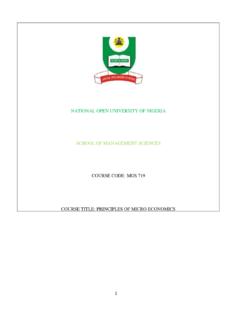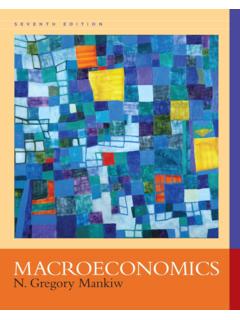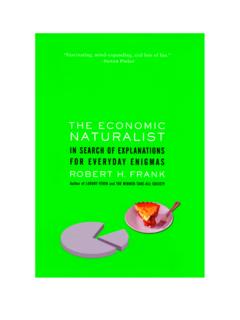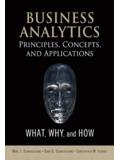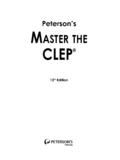Transcription of The Demand for Health Care Services - World Bank
1 554 The Demand for Health care ServicesIndividuals make choices about medical care . They decide when to visit adoctor when they feel sick, whether to go ahead with an operation, whetherto immunize their children, and how often to have checkups. The processof making such decisions can be complicated, because it may involve accu-mulating advice from friends, physicians, and others, weighing potentialrisks and benefits, and foregoing other types of consumption that could befinanced with the resources used to purchase medical care . This chapterpresents some simple tools for describing these choices and making em-pirical estimates of the effects of certain factors, such as prices, incomes,and Health have employed two alternative models for describing theway individuals make choices regarding Health care utilization and relateddecisions. A simple approach, which we shall follow for the most part, is totreat Health as one of the several commodities over which individuals havewell-defined individual preferences, and to use orthodox consumer theoryto investigate the determinants of Demand (see Phelps 1992, chapters 3and 4, for a similar presentation to that used in this chapter).
2 A question ofinterpretation then arises as to whether we should think of individuals ashaving preferences for Health , or for Health care . One can argue that, ingeneral, Health care is only valued to the extent that it improves Health , sothat Health should be primitive in the description of consumers prefer-ences. Yet, Demand for Services is more easily observed and quantified, soa mapping between the two concepts is second approach to analyzing Health care choices is to use anintertemporal model of consumption decisions and to treat Health as astock variable within a human capital framework. Health care use can cer-tainly have long-lasting effects, and the idea of Health care representing an56 microeconomics of Health care and Insurance Marketsinvestment in Health has been popular at least since the World Bank s 1993 World Development Report (the subtitle of which was Investing in Health ).
3 Infact, the approach was originally pioneered by Grossman (1972) in a modelin which individuals consume Health care not because they value healthper se, but because it improves their stock of Health , which is used as aproductive resource. Cropper (1977) extended Grossman s model to ac-count for the disutility that illness may impose on individuals, and to ex-amine differences in the Demand for preventive and curative care , and thedynamics of Demand over the life cycle. Couched firmly in human capitaltheory, these models value Health care Services in terms of their potentialto improve productivity. While this is clearly one outcome of better Health ,the consumption value of improved Health status would suggest that suchmeasures are lower in this chapter we describe the Demand for Health care serviceswithin an orthodox static utility-maximizing framework.
4 As alluded toabove, the first issue we must address regards the appropriate choice ofgoods that enter the utility function. On the one hand, it is natural to thinkof individuals as having preferences for Health care Services directly. De-pending on their Health needs, these preferences change, so we need tomake the utility function state dependent. Alternatively, we might think ofindividuals as having preferences for Health . Health care Services wouldthen be demanded only as an input into the production of Health , and thelevel of Demand for Services would be determined by the extent to whichthey satisfied the individual s underlying preference for Health . Preferencesfor Health would then be independent of Health status, and Health caredemand would change as the onset of illness altered the way in whichmedical care Services could improve Health .
5 We adopt the second of theseapproaches and use it to examine the effects of Health status, income, andprice on the Demand for medical to the existence of insurance, many Health care Services are providedat zero or low monetary prices, and so the standard model would suggestthat Demand should be infinite, or at least extremely high. Indeed, excessdemand by some insured individuals is seen as a problem in many indus-trial economies, but in the developing country context, underutilization isgenerally more of a concern. The main reason for this is a lack of supply,especially in rural areas. But even when clinics and Services are available,utilization rates can be low, due to both significant nonpecuniary costs ofconsuming medical Services and poor quality. With this in mind, we intro-duce travel costs into model of Demand , as well as quality Demand for Health care Services 57 Next we recognize that the Demand for medical care is not constrainedto a choice of how much, but also of what kind.
6 Thus, individuals can chooseamong visiting a hospital, clinic, or traditional healer, as well as how oftento visit. The existence of such discrete choices means that somewhat moreelaborate econometric techniques are required to estimate Demand of such Demand patterns may also allow policymakers to tar-get Services more , we analyze the extent to which information about Demand canbe used to make judgments about social welfare. These techniques will beof use later when we consider appropriate Health care financing mecha-nisms (chapter 6) and the appraisal of Health care projects (chapter 8).Preferences for Health and Health CareWe start with a very simple representation of preferences for Health withina standard utility-maximizing framework: individuals use their availableresources to acquire Health . To admit a substantive choice, individuals musthave alternative uses for their resources.
7 We bundle all of these alternativeuses into a generic consumption good, denoted c. Utility is then representedas a function u(c,h), where h is the level of Health ; h is not the quantity ofhealth care Services consumed, but rather the level of Health that the indi-vidual enjoys. We assume that greater Health and higher levels of otherconsumption make the individual better-off, and that an increase in onecoupled with a decrease in the other (of a particular magnitude) leaves theindividual s well-being unchanged. Thus we can draw standard indiffer-ence curves representing preferences between h and c, as in figure do we interpret the variable h? Introspection suggests that we knowwhen we are feeling healthy and when we are not, but can we really hopeto quantify Health levels using a particular unit? This is the subject of alarge literature, and we shall have cause to address it more fully in chapter9, but for now we should at least be keeping such concerns at the back ofour minds.
8 In some instances, a natural unit might suggest itself: for ex-ample, a person with terminal cancer might measure her Health in expectednumber of years of life, although given the potentially severe Health sideeffects of life-prolonging anti-cancer drugs, such a measure may be woe-fully inadequate. It is sufficient to leave interpretation of h to one side andto use it only as a vehicle to derive the (observable) Demand for medicalcare Services , as we do below. However, if the social welfare implicationsof the allocation of Health among individuals are thought to differ from58 microeconomics of Health care and Insurance Marketsthose associated with the allocation of ordinary goods, a quantifiable mea-sure of h itself is let us consider how the simple description of preferences can beused to determine the Demand for medical care . Consistent with the dis-cussion in the introduction to this chapter, we assume that medical care isdesired only for its use in producing Health .
9 In general, its effectiveness inthis regard depends on the Health status of the individual (as well as otherfactors). We assume for now that the production process is very simple,and that in order to produce an additional unit of Health , units of medicalcare are required. provides a natural index for the Health status of anindividual the higher is , the sicker the individual is. Thus h representsthe level of Health , and represents the Health status (or the [inverse of the]productivity of Health care Services in producing Health ).One caveat to this representation of the production of Health is that it isalmost certain that there are decreasing returns to medical care , so that therequired inputs of medical care per unit of Health improvement increase atthe margin. While this is undeniably true one only has to consider themarginal increase in days lived because of successively more intrusive andFigure Curves Representing Preferences over Health andOther Consumption Goodsc-consumptionh-healthSource: Demand for Health care Services 59costly medical interventions in old age the assumption of constant re-turns to scale is convenient for our illustrative the simple description of the technology of Health production, itis straightforward to characterize the set of feasible Health -consumption pairsthat an individual can choose between that is, the budget set.
10 For a par-ticular Health status, , an individual with income m faces a budget con-straintc + h m, where for now we assume that the prices of consumptionand medical care are both unity. When the individual becomes ill, the valueof increases, and the boundary of the budget set swings inward, as shownin figure Notice that the effect of getting sick, in this model, is just thesame as having the price of Health (not Health care ) would expect people who are sicker to have greater Demand formedical Services , other things being equal. At the same time, we wouldexpect them to have a lower Demand for Health , because Health has effec-tively become more expensive. These conditions will be met if we supposethat the (absolute value of the) price elasticity of Demand for Health is be-tween zero and one: that is, if a proportionate increase in the price of healthleads to a less than proportionate decrease in the desired amount of a case is shown in figure Constraints and Optimal Consumption Bundles forIndividuals with Different Health StatusSource: set when wellBudget set when illh1h2c2c1c60 microeconomics of Health care and Insurance MarketsWhen the elasticity condition is satisfied, we can draw indifferencecurves between consumption and Health care Services in a convenient man-ner.











